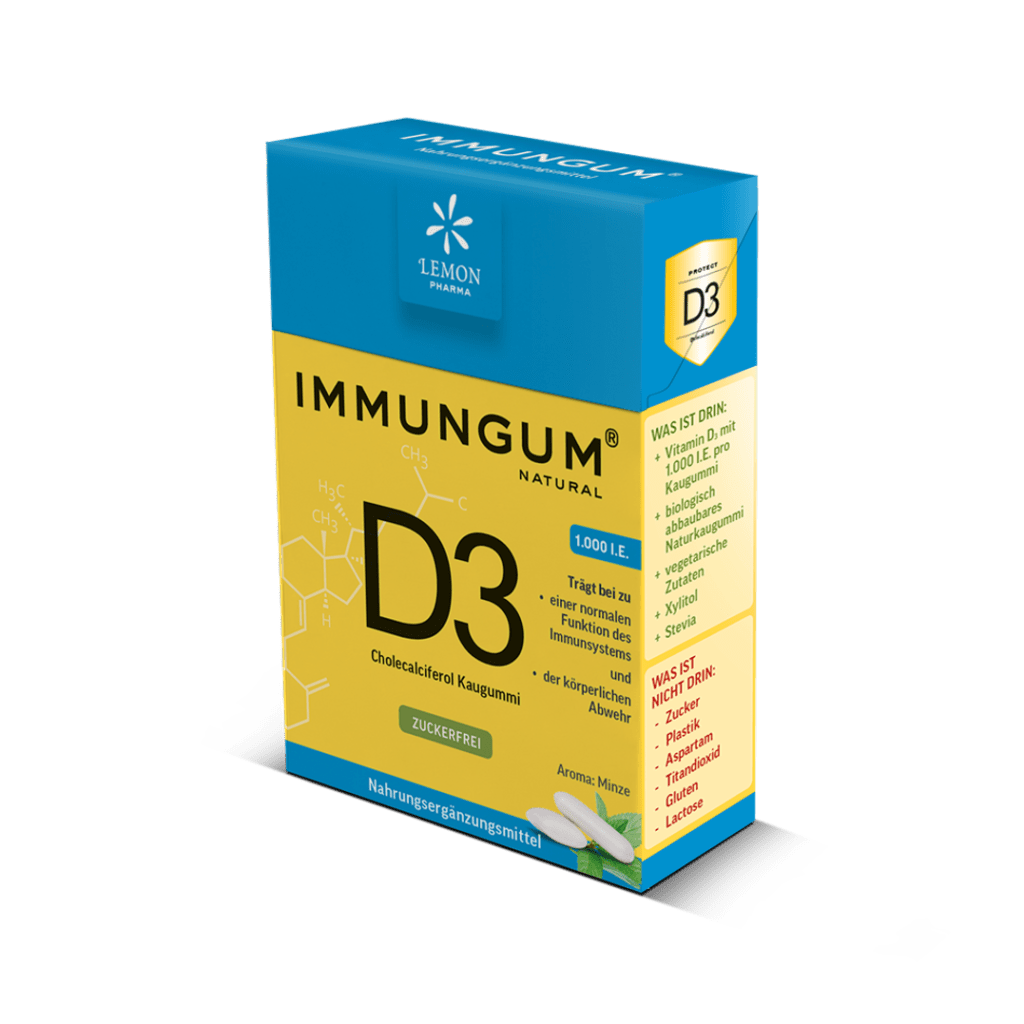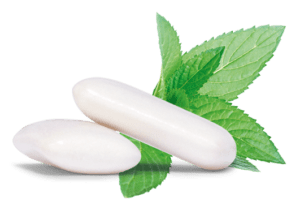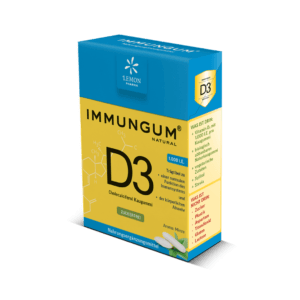

IMMUNGUM® - STRENGTHEN YOUR IMMUNE SYSTEM SUSTAINABLY WITH VITAMIN D3
Our immune system consists of an interplay between certain cells, signaling substances and tissues. Along with the nervous system, it is one of the most complex systems in the human body. The defense against pathogens takes place at different levels Certain pathogens are already „intercepted“ in the mouth by saliva and the mucous membranes. One of the the most important vitamins for a successful reaction of the immune system is VITAMIN D3.
The European Food Safety Authority (EFSA) considers a number of health claims from vitamin D3 to be secure. The following is essential for the IMMUNGUM® product:
- Vitamin D3 contributes to a normal functioning of our immune system and physical defences.
IMMUNGUM benefit N°1: vitamin D3 is administered sublingually and absorbed by the oral mucosa and not over the intestines. Vitamin D3 reaches the bloodstream directly through the ventral surface of the tongue and the base of the mouth:
- Highly effective because vitamin D3 is absorbed by the oral mucosa
Another novelty is the use of 100% biodegradable gum. Unlike other chewing gums, IMMUNGUM does not contain plastics, but an organic gum base, which is 100% biodegradable. It is harvested from the sapodilla and is sweetened and flavored with xylitol and stevia. The tree grows in the tropics of Central America, where the sap is harvested using sustainable methods. Tree populations are protected because they make an important contribution to climate protection as CO2 stores.
The occurrence of vitamin D3 in nature is very limited. Cow’s milk and breast milk contain less than 5 I.U. (International Units) per 100 ml. However, in addition to vitamin D3, active vitamin D metabolites are also present in very low concentrations.
Fish liver contains very high amounts of vitamin D3 (cod liver oil). The following overview gives a selection of foods that contain appreciable amounts of vitamin D3 (vitamin D3 content in µg per 100 g).
Eel 90
Herring 30
Meat < 10
Cheese < 1
Dairy products < 1
However, vitamin D3 holds a special position among the vitamins, as it is both supplied through the diet and formed by humans themselves through UVB light exposure (sunlight). The intake via the diet with the usual foods is often not sufficient to ensure a desired supply of vitamin D3. Only frequent sun exposure can achieve the desired supply without taking a vitamin D product. However, vitamin D synthesis in the skin is determined by geographical, climatic and cultural factors. These include, for example, latitude, season, time of day, sunshine duration and clothing, as well as the length of time spent outdoors. Other influencing factors include the use of sunscreens, the pigmentation of the skin and the thickness of the skin, which decreases with age.
In the summer months, however, it is possible to achieve the desired vitamin D intake through endogenous synthesis. In Germany, however, the UVB index falls below 3 for about 6 months of the year and thus sufficient vitamin D synthesis is not guaranteed.
The contribution of endogenous synthesis of vitamin D3 supply by UVB light exposure when spending time outdoors needs to be investigated in more detail in the future. On the one hand, UVB exposure is necessary for vitamin D synthesis; on the other hand, UV exposure increases the risk of skin cancer, especially in our modern times. In addition, the increased use of sunscreens has been advised for some years. However, it should be noted here that the use of day creams with a sun protection factor and the use of sunscreens significantly reduce vitamin D synthesis in the skin.
However, a lack of vitamin D supply can cause health problems for humans. These possible risks are described in detail in the literature. Therefore, especially for older people (older than 60), a balanced supply of vitamin D3 is also recommended in the winter half-year via appropriate dietary supplements or via medicines.
The German Society for Nutrition recommends 20 µg vitamin D3/tgl for children from 1 year of age, adults, pregnant and breastfeeding women with a lack of endogenous synthesis.
The European Food Safety Authority (EFSA) already established the following Tolerable Upper Intake Levels for vitamin D3 in 2012.
2) Vitamin D in Food:
Food | Vitamin D (Microgram per 100 gram) |
| Herring | 7,80 – 25,00 |
| Salmon | 16,00 |
| Chicken egg yolk | 5,60 |
| Mackerel | 4,00 |
| Chicken egg (total) | 2,90 |
| Margarine | 2,50 – 7,50 |
| Chanterelles | 2,10 |
| Champignons | 1,90 |
| Beef liver | 1,70 |
| Gouda cheese, 45% F. i. Tr. | 1,30 |
| Butter | 1,20 |
| Calf’s liver | 0,33 |
3 ) Vitamin D supply in Germany:
The largest amount of vitamin D is taken in through fish (approx. 33 %) and fish products (approx. 15 %). About 10 % each of the vitamin D intake comes from fats, eggs and milk/cheese (Max Rubner Institute 2008).
In the study “Ernährung ab 65” (Stehle et al. 2000), 3-day dietary protocols of the 583 male participants showed a median vitamin D intake of 3.6 μg per day (P5 – P95 1.0 – 10.6 μg per day), the median vitamin D intake of the 789 female participants was 2.9 μg per day (P5 – P95 0.8 – 8.2 μg/day). 84% of men and 91% of women did not reach the recommended intake of 10 μg per day, 61 and 71% respectively consumed less than half of the recommended amount.
In children and adolescents, the median intake is even lower: according to the EsKiMo study (nutrition module of the KiGGS study), 6- to 11-year-old boys consume 1.4 μg and girls of the same age 1.3 μg of vitamin D per day. Boys aged 12 to 17 have a median vitamin D intake of 2.2 μg and girls in this age group have an intake of 1.7 μg vitamin D per day (Mensink et al. 2009).
Consequently, the median vitamin D intake of 65-80 year old seniors reaches only about a quarter of the recommendation. However, adolescents and young adults aged 14-24 are also conspicuous for their low median vitamin D intake compared to the reference values. A total of 82 % of men and 91 % of women do not reach the recommended daily vitamin D intake. The proportions are highest among adolescents and young adults (>86 % for men, >96 % for women) and seniors (94 % for men and 97 % for women).
The situation also worsens in the northern hemisphere during the winter months. This is confirmed by numerous researchers and nutritionists. Prof. Dr. Zittermann deals with this in particular in his paper “The estimated benefits of vitamin D for Germany”. The body’s own vitamin D synthesis comes to an almost complete standstill during the winter months.
The first signs of a vitamin D 3 deficiency can be associated with an increased susceptibility to infections, especially in the winter months.
4) On the safety of vitamin D3:
As early as 2002, the Scientific Committee on Food (SCF) defined a Tolerable Upper Intake Level (UL value) of vitamin D as follows:
Summery of upper levels for vitamin D:
| Age (in years) | Tolerable Upper Intake Level (UL) for vitamin D (µg/day) |
| 0-2 | 25 |
| 3-10 | 25 |
| 11-17 | 50 |
| Adults + | 50 |
+This value also applies to pregnant and breastfeeding women.
The “Reference Values for Nutrient Intake 2008” already state: “A daily vitamin D intake of up to 50 µg can be considered safe for adults”.
Current levels:
Based on today’s findings, the European Food Safety Authorities (EFSA) already set new Tolerable Upper Intake Levels for vitamin D in July 2012:
Age | Tolerabel Upper Intake Level (UL) for vitamin D (µg/day) |
| Kids | 1000 IU (25 µg/Tag) |
| Kids 1 – 10 years | 2000 IU (50 µg/Tag) |
| Kids 11 – 17 years | 4000 IU (100 µg/Tag) |
| Pregnancy and breastfeeding | 4000 IU (100 µg/Tag) |
| Adults (18+ years) | 4000 IU (100 µg/Tag) |
In addition, as a safe upper intake limit, the Institute of Medicine (IOM) doubled the dose from 2000 units to 4000 units per day for adults and set it at 1000 – 3000 units per day for children depending on age in its latest vitamin D recommendations.
In this regard, the summary statement reads:
The majority of the working group members come to the following conclusion: For older people (≥ 65 years), a daily intake of at least 800 IU (20 μg) of vitamin D should be recommended
- as this dose has been shown in intervention studies to reduce the risk of musculoskeletal dysfunction, falls, fractures, and premature death with convincing or probable evidence,
- as this dose has been shown in intervention studies to reduce the risk of musculoskeletal dysfunction, falls, fractures, and premature death with convincing or probable evidence
- and no significant risks or side effects are expected at this dose.
Age | Vitamin D in the absence of endogenous synthesis µg1/day |
| Infants (0 to under 12 months) | 10 |
| Children (1 to under 15 years) | 20 |
Young people and adults (15 to under 65 years) | 20 |
| Adults from 65 years | 20 |
| Pregnant women | 20 |
| Breastfeeding women | 20 |
1 1 µg = 40 International Units (IU); 1 IU = 0.025 µg
Daily or weekly intake?
However, these amounts can also be consumed in higher dosages, as numerous studies show, 1x weekly or in even higher dosages 1x monthly.
Instead of daily supplementation with vitamin D, the dosage for the whole week or month can also be consumed once a week or once a month.
4. Safe upper limits of vitamin D3:
Intoxications could not be proven even with daily intakes of up to 100 μg. However, at intakes of more than 100 μg per day, an increase of the calcium concentration in the plasma may occur in isolated cases despite an increased excretion of calcium in the urine.
Tolerable upper limit of intake
In infants, daily amounts of more than 25 μg of vitamin D must not be given without a targeted indication and regular monitoring of the calcium concentration in the plasma and calcium excretion via the urine. The EFSA assesses a daily vitamin D intake of up to 50 μg for adults as safe. The US Institute of Medicine has set the tolerable upper limit for daily vitamin D intake at 100 μg.
According to the work of Hathcock, toxic effects are to be expected with daily intakes of > 250 µg. Therefore, the American Society of Endocrinology also set the daily upper limit for the intake of vitamin D in summer 2011 with a UL value (Upper Safe Limit) for adults of 10,000 I.U. per day, corresponding to 250 µg (DAZ 2011, No. 29, p. 67).
The dietary regulation also allows a vitamin D intake of up to 2.5 or 3.0 µg/100 kcal/day in Appendix 6. With an average calorie intake of 2000 kcal, this corresponds to a value of 50-60 µg vitamin D.
5. Summary assessment of the marketability of vitamin D
Numerous studies show that an adequate vitamin D supply can be provided by a lower daily dosage or in a higher dosage 1x weekly or even 1x monthly.
Physiologically, there are no significant differences.
As early as 2012, the EFSA specified a Tolerable Upper Intake Level (UL value) of 100 µg/day for vitamin D3, i.e. a total daily intake at this level is still considered safe from a nutritional-physiological point of view.
The current intake recommendations in the DACH reference values are stated as 20 µg/day corresponding to 800 I.U.
6. Assured statements on vitamin D3:
The substantiated statements on vitamin D3 are listed in Regulation No. 432/2012/EU:
Vitamin D contributes to a normal absorption/utilisation of calcium and phosphorus.
Vitamin D contributes to normal blood calcium levels.
Vitamin D contributes to the maintenance of normal bones.
Vitamin D contributes to the maintenance of normal muscle function.
Vitamin D contributes to the maintenance of normal teeth.
Vitamin D contributes to normal immune system function.
Vitamin D has a function in cell division.
WHAT IS IN IT
- Vitamin D3 with 1,000 I.U. per chewing gum
- Biodegradable natural chewing gum
- Vegetarian ingredients
- Xylitol
- Stevia
WHAT IS NOT IN IT
- Sugar
- Plastic
- Aspartame
- Titanium dioxide
- Gluten
- Lactose
IMMUNGUM® makes the sun shine
Conventional chewing gums
- Most often contain microplastics (mainly polyisobutylene and polyvinyl acetate)
- They are not biodegradable
- They will stick to the asphalt of our streets forever
- Most often contain aspartame (synthetic sweetener) and titanium dioxide (whitening additive)


IMMUNGUM® with Chicle gum base
- The Chicle gum base is extracted according to a centuries-old traditional method by the chicleros
- The chicleros climb Manilkara trees and carve them in a way that the sap can drain into a container.
- This process is similar to the extraction of maple syrup and does not harm the tree
- The extracted milk sap is processed into a gum base, which is the main ingredient of our IMMUNGUM®
- That makes the chewing gums biodegradable and they do not contain plastic
- IMMUNGUM® is the first chewing gum with a chicle gum base and vitamin D3 (1000 I.U.) that is classified as a food supplement.

Chewing gum
1000 U.I.
IMMUNGUM® Vitamin D3, chewing gum
- 1000 U.I.
- Sugar-free
- Mint flavour
Recommended consumption:
Take 1 chewing gum per day. One chewing gum provides 500% of the recommended daily intake of the vitamin (1000 i.U.). Excessive consumption may have a laxative effect.
Note:
Do not exceed the recommended daily intake. Food supplements are not a substitute for a balanced diet and a healthy lifestyle. Keep out of reach of children. Store in a dry place and away from light, at a temperature below 25°C.

| Nutritional values | Per 100 g | Per 1 chewing gum |
| Energy | 767kj/ 184kcal | 11kj/ 2,5kcal |
Fat of which saturates | 0,0 g 0,0 g | 0,0 g 0,0 g |
Carbohydrate of which sugars of which polyhydric alcohols | 76,0 g 0,0 g 76,0 g | 1,1 g 0,0 g 1,1 g |
| Protein | 0,0 g | 0,0 g |
| Salt | 0,0 g | 0,0 g |
| Vitamin D3 (cholecalciferol) | 1.736 μg/ 34.722%* 69.444 U.I. | 25 μg/ 500%* 1.000 U.I. |
* Percent of the nutrient reference values (NRV) according to EU regulation 1169/2011
LEARN MORE
Would you like to know more about these products? Please do not hesitate to contact us!
Send us an email info@lemonpharma.com
or give us a call: +49 211 17904 80









